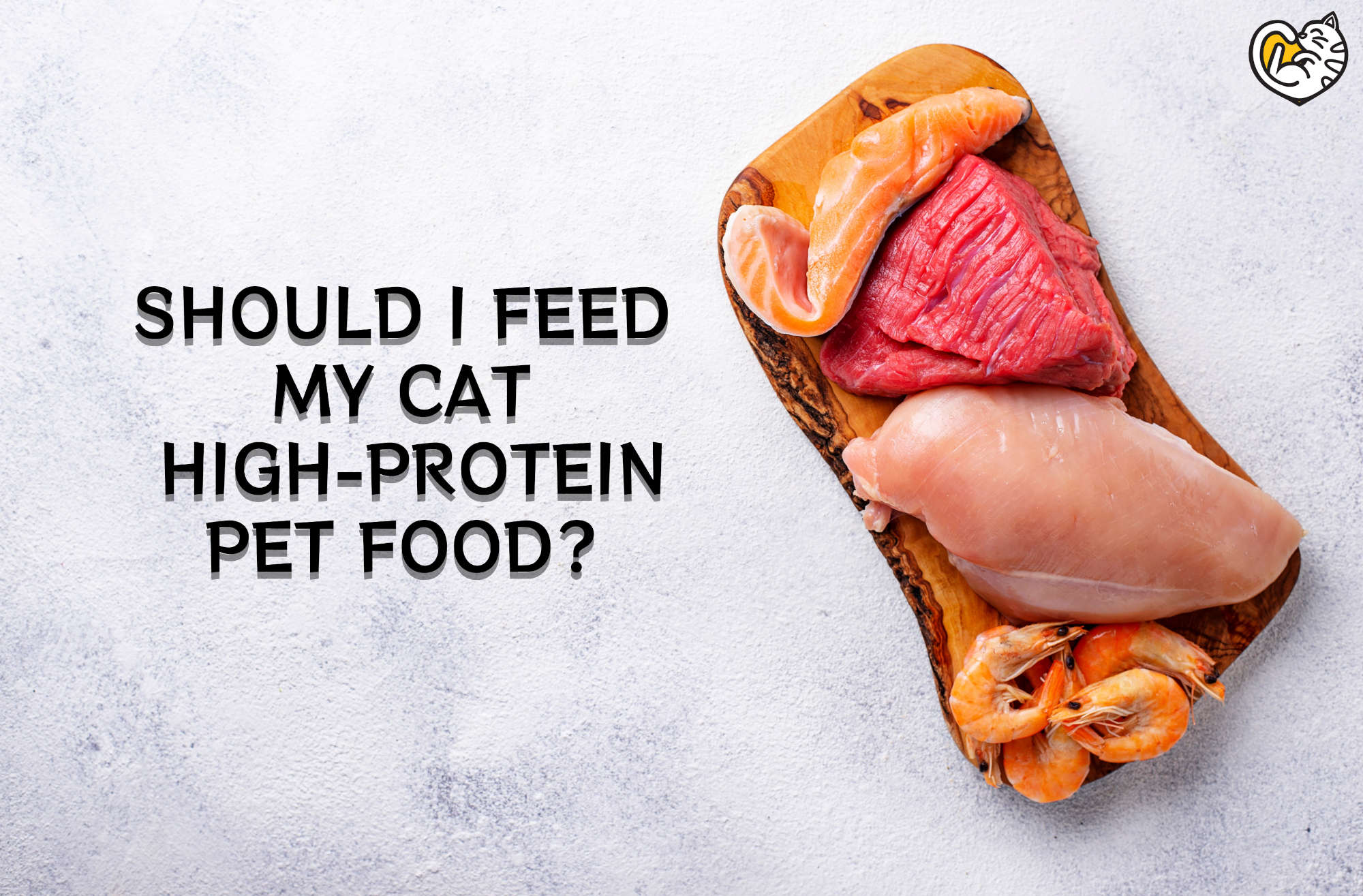Should I Feed My Cat High Protein Pet Food?

Choosing a pet food for your cat is not always that straightforward. Pet food with complete and balanced feline nutrition would keep your pet healthy and happy.
Research has shown that one of the most important nutrients for our fur friends is protein. In this article, we will learn about protein for cats and whether should we feed our cats high-protein pet food.
Want your cat to live the longest, healthiest, and happiest life?
It starts with what’s in their bowl.
Every meal is a chance to give your cat more energy, fewer vet visits, a shinier coat, and a longer, happier life by your side.
Choose food that truly understands your cat’s needs.
Choose Grace Cat. 🐾
Malaysia’s First Freeze-Dried Complete Meal With Krill Oil & Postbiotic
What Is Protein and Why Is Protein Important for Cats?
Protein is an important macronutrient that does all kinds of jobs in all of life, from building muscle tissues, coordinating body functions to maintaining proper fluids.
Protein is built from a set of amino acids which constitute a distinctive part of a cat’s body. When eaten, protein is broken down into amino acids to be used by the body.
A cat needs 22 types of amino acids, whereby 11 of these amino acids can be synthesized on its own (a.k.a. non-essential amino acids), and the remaining ones must be consumed through the cat’s diet as the body cannot make them internally (a.k.a. essential amino acids).
Humans need 9 types of essential amino acids; dogs need 10; while cats need 11 essential amino acids namely:
- Arginine
- Histidine
- Isoleucine
- Leucine
- Lysine
- Methionine
- Phenylalanine
- Taurine
- Threonine
- Tryptophan
- Valine
How to Find the Protein Content in a Pet Food?
You should always read the ingredient list and nutrient profile together to understand the protein content in pet food.
1. Ingredient List
According to the legal requirements, all ingredients must be listed from the heaviest to the lightest by weight.
Protein sources should always be listed as the first in cat food unless a cat is on a special medical diet. On top of that, the protein sources should also be “named specifically” in the list e.g., chicken, duck, salmon etc., instead of just listing a general name like “meat”, “meat products” or “meat derivatives”.
It is advisable to avoid questionable ingredients like grains, peas, soy, chemical preservatives, seasonings, colourings and “mystery meat” which can be potentially harmful to your pets.
2. Nutrient Profile
A nutrient profile or guaranteed analysis should list the amounts of certain nutrients which include crude protein, crude fat, crude fibre and moisture, as per the requirement of The Association of American Feed Control Officials (AAFCO). Some pet food labels also additionally disclose crude ash, fatty acids, vitamins and others.
Even if you see protein sources as the first in an ingredient list, it is still early for it to be such good news. You shall look further into the nutritional label to determine the amount of protein on a dry matter basis (which means the nutrient percentages are calculated without considering moisture content).
By looking at both the ingredient list and nutritional label, we can get a more complete picture of what is being fed to our cats.
High-Protein Wet Cat Food vs. High-Protein Dry Cat Food
Kibbles tend to have a lot of carbohydrates and lower protein.
Many wet cat foods have a higher level of protein than kibbles, although they can be also high in carbohydrates. Even though the protein content on a wet food label may look low, when the water or moisture content is removed, the product may be a high protein wet cat food.
This is because many pet food labels normally show nutrient content on an “as-fed” basis, which includes water. This does not create a direct comparable percentage because wet cat food contains a lot more water than kibbles. Thus, what we can do is to convert an “as-fed” basis into a “dry matter” basis to compare and understand how much protein is exactly in a food.
How Much Protein Does My Cat Need?
Cats require a significantly higher amount of protein in their diet than humans or dogs.
The AAFCO determines that the content of protein in an adult cat’s diet should be at least 26% (on a dry matter basis), while cats in growth and reproduction need at least 30%.
Nevertheless, the AAFCO guidelines are merely a bare minimum requirement of protein for a cat to survive. Most cats do better with an even higher level of protein in their diets, at about 50%.
There are recent studies that have shown that adult cats consuming proteins lesser than 40% tend to lose their body muscle mass over time. Cats consuming poor quality or less-digestible protein will result in quicker loss of lean body mass as compared to high-quality protein.
What Are the Good Sources of Protein for My Cat?
While it is important to ensure that the percentage of protein in a cat’s diet is sufficient, it is even more important to determine the source and quality of the protein itself.
Proteins can be found in animals and plants. The type and amount of each amino acid vary based on the source of protein.
Animal Protein Vs Plant Protein
Animals are the best quality protein sources with complete proteins. On the other hand, plants are often incomplete sources of protein.
Animal protein sources such as chicken, fish and eggs contain all the essential amino acids that a cat needs for the body to function properly.
Plant protein sources such as legumes and grains have an incomplete or very little amount of certain amino acids which is not comparable to animal proteins.
For instance, cats have a special need for taurine which is found naturally in only animal proteins. There is no appreciable amount of taurine found in any plants. While synthetic taurine supplements are widely available and can be added to a cat’s diet, their digestibility is lower compared to the natural sources found in animal proteins.
Therefore, although plants and synthetic nutrients can be a part of a cat’s diet, cats still need animal-based sources as the main food for a better quality of complete nutrition.
Many of the pet foods in the market that claim themselves as “high-protein pet food” are actually packed with plant proteins such as soy, peas and corn. However, we have just learnt that plant proteins are of inferior quality as compared to animal proteins. Hence, it is very important to not only look at the nutritional information but also the ingredient list together. Even though the protein amount is high in pet food, it is not such good news for your pet if the protein sources are not from animals.
Is High-Protein Pet Food Suitable for All Cats?
Cats at different life stages may need different amounts of protein in their diets. Let us look at the breakdown by life stages for better understanding:
1. Kittens (from 0 to 1 year old)
Kittens are in explosive growth thus they need more energy to support their higher activity levels. They require at least 30% to 40% of their energy from protein sources.
2. Adults (from 1 year old to 6 years old)
Most adult cats need at least 26% to 40% of protein in their diets.
Some may ask if a cat can get too much protein? The answer is “Excessive protein does not result in better health, but at the same time is also unlikely to be harmful to your pet because a healthy cat can break down excessive protein and eliminate it in the urine.”.
3. Middle-aged Cats or Seniors (from 7 years old onwards)
Generally, older cats’ protein requirements increase along with age due to a decrease in digestive efficiency. Cats at age of 12 or more should take cat food with nearly 50% protein.
However, at the same time, older cats are at risk of developing Chronic Renal Failure or Chronic Kidney Disease as cats’ kidneys can start to fail with age.
This is the tricky part. Feeding high protein food to cats with kidney failure can worsen the situation. While too low protein can cause a loss in cats’ muscle mass.
Therefore, it is important for senior cats to have health checks from time to time to see how the kidneys are functioning. A high protein diet is encouraged if the kidneys are still good. On the other hand, a low protein diet may be necessary if your cat has started developing kidney disease.
Cat Allergies to Protein
The symptoms of cats having food allergies include vomiting or diarrhoea, over-grooming themselves, skin problems and ear infections.
Food allergy is the third most common allergy in cats, although environmental allergies and flea bite allergies are the much more common allergies. These allergies can all have similar symptoms such as itchy skin and skin infection.
The most commonly associated food allergens for cats are animal protein sources such as beef, fish and dairy products. Grains although can also cause allergy to cats, they are not the most common cause of food allergies.
Finding the food allergen for your cat is not an easy process. The best method recommended by the veterinarian for diagnosing food allergies is by food trial.
A cat on food trial must only eat a special diet recommended by the vet, for at least a month or more. That means strictly no other pet treats or snacks are allowed.
If the symptoms have improved after the food trial period, the cat will be re-introduced into its old food. If the signs return within a week of eating old food, then the cat is diagnosed to have a food allergy. If the symptoms do not improve after the food trial period, then it is probably not a food allergy but is due to other causes.
Proteins for Cats with Obesity
A high protein diet can be particularly helpful for overweight cats.
Cats derive energy from three nutrients i.e., proteins, fats and carbohydrates. Therefore, low fat or low carbs diets generally lead to higher protein diets. Studies showed that cats who eat high protein diets burn more calories than moderate protein diets. This is because a high protein diet will lead to a higher body muscle mass which burns more calories. As such, high protein diets are also used for pets with muscle loss problems.
Conclusion: High Protein Cat Food
Protein is definitely a vital nutrient to keep our cats healthy and happy.
However, we should be careful of the sources and amounts of protein in cat food.
Animal proteins are the best quality of protein with complete amino acids, but not plant proteins. High-protein cat food is a good choice for most cats especially kittens and adult cats, unless the cats are allergic to protein. While for senior cats, the amount of protein depends on the functionality of kidneys, it is best to seek advice from the veterinarian.
Looking for a great quality high-protein cat food? Grace Cat’s GraceFull RAW Freeze-Dried Pet Food is a high-protein pet food with only quality animal proteins. Check it out here.
Still feeding low-quality pet lick treat to your pets?
You could be giving them a time bomb in disguise — one that slowly harms their health, weakens their immunity, and makes them sick.
It’s time to switch to safer, healthier options — before it’s too late.
Try out our gloow Nutrition Pet Lick – The first Algal Oil & Postbiotic Pet Lick in Malaysia









